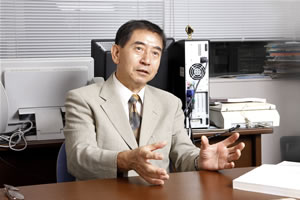2010/05/10
“Computer Aided Surgery” reaches out to the physically-challenged
Professor Takeyoshi Dohi
(Department of Mechano-Informatics)

Professor Dohi is a researcher who pioneered “Computer Aided Surgery” research that supports human lives by integrating information science and technology and clinical medicine. It is his firm desire “to help the physically-challenged who may end up in a wheelchair for the rest of their lives if no action is made.” He paved the way for a new research field based on the know-how of developing assistive and rehabilitative devices such as artificial arms and legs.
It was around 1987 when a surgeon in the Faculty of Medicine at the University of Tokyo brought CT images in his hand and asked for help explaining “it is obvious that cancer tissue is here but when we examine the location by performing an operation and using ultrasound, the cancer tissue cannot be found.” Professor Dohi then came across the idea that treating cancer by manipulating a robot and images might be effective if its location is known. A network of Computer Aided Surgery research spread throughout the nation in collaboration with researchers in medicine and engineering and industry. Professor Dohi contributes to organizing domestic and international academic conferences and provides leaderships.
Adopting a robot in today' s medical scene is not easy because a robot is expected to have better skills and capabilities than those of a surgeon. Professor Dohi set some examples including medical 3D image processing technology as a starting point. If technology to project a precise stereo image of organs such as brain and liver in 3D space is available, organs in treatment can be examined as if they are in surgeon' s hand without surgery. Navigation technology to simulate surgery path can generate high precision images by combining ultrasound, X-ray CT, and MRI images, and based on such images cancer tissue can directly be treated with drug injection and suction. An endoscopic robot is a step towards the dream of operating and examining the inside of the heart without having to stop it.
Doctors in brain surgery, abdominal surgery, and orthopedic surgery, and researchers in information science and engineering formed a network around Professor Dohi and they are striving to enable Computer Aided Surgery in the medical scene.

